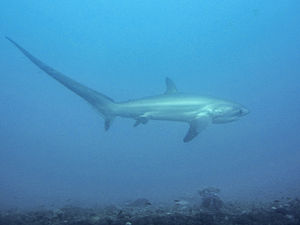Thresher sharks
| Thresher sharks | ||||||||||||
|---|---|---|---|---|---|---|---|---|---|---|---|---|

Thresher shark ( Alopias vulpinus ) |
||||||||||||
| Systematics | ||||||||||||
|
||||||||||||
| Scientific name of the family | ||||||||||||
| Alopiidae | ||||||||||||
| Bonaparte , 1838 | ||||||||||||
| Scientific name of the genus | ||||||||||||
| Alopias | ||||||||||||
| Rafinesque , 1810 |
The thresher sharks ( Alopias ), also Drescher sharks (eng. Thresher sharks) called worldwide are living with three types, free-floating ( pelagic ) in all oceans up to 500 meters depth.
anatomy
Characteristic for these 3.5 to 7.5 meters long sharks is the long upper lobe of the caudal fin , which can be extended almost as long as the rest of the body. This long piece of tail fin is used to stun prey fish, as can be seen on film recordings. Hence the name thresher sharks. With the help of their long tail lobe, thresher sharks can also jump out of the water.
In addition to their strikingly long upper caudal fin lobes, thresher sharks also have long pectoral fins. Thresher sharks have small single-pointed teeth. Its mouth and gill openings are small, and the eyes are large. The attachment of the pectoral fins lies under the 3rd to 5th gill slit.
Way of life
Thresher sharks often feed on schooling fish such as herrings and mackerel . They circle their prey and stun them with blows with their long tail fins before they eat them with their mouths. Thresher sharks are harmless to humans.
Thresher sharks are viviparous ( ovoviviparous ). You get one to four juvenile fish per litter.
species
- Pacific thresher shark ( Alopias pelagicus Nakamura, 1935 )
- Bigeye thresher ( Alopias superciliosus Lowe, 1841 )
- Common thresher shark ( Alopias vulpinus (Bonnaterre, 1788) )
literature
- Joseph S. Nelson : Fishes of the World . John Wiley & Sons, 2006, ISBN 0-471-25031-7 .
- Kurt Fiedler: Textbook of Special Zoology, Volume II, Part 2: Fish . Gustav Fischer Verlag Jena, 1991, ISBN 3-334-00339-6 .
Individual evidence
- ↑ http://www.wired.com/wiredscience/2010/11/repost-shark-mystery-solved-how-thresher-sharks-use-their-tails/
- ↑ http://www.new-brunswick.net/new-brunswick/sharks/species/thresher.html
Web links
- Thresher Sharks on Fishbase.org (English)